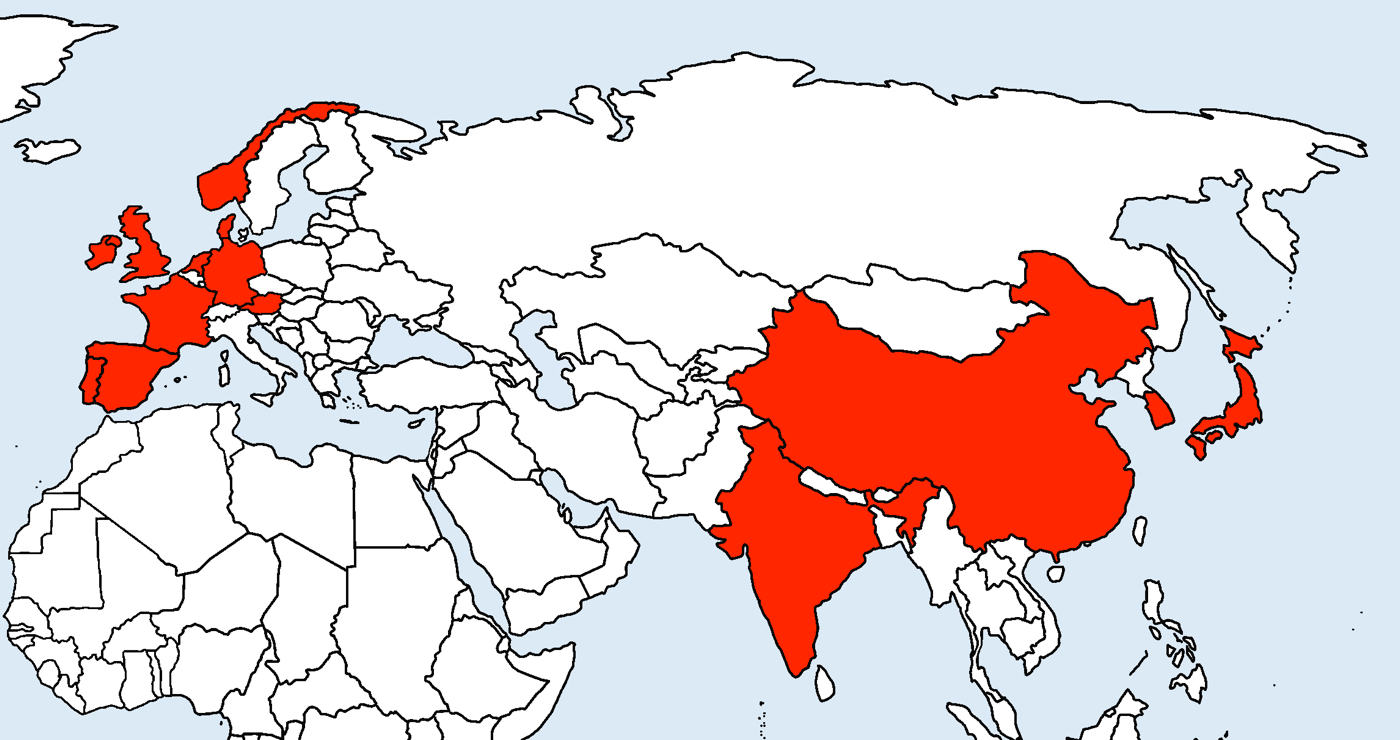Just a quick scan of news sites helped me put together a list of countries who have announced an end date for gasoline- or diesel-powered car sales:
- China (no date set)
- India 13 years from now
- France 23 years
- Britain 23 years
- Norway 8 years
- Scotland 15 years
- Netherlands 8 years
These countries have set EV sales targets, but no end date has been set for gasoline- and diesel-powered passenger vehicle sales to end…yet.
- Germany
- Austria
- Denmark (I could have sworn they set a date)
- Ireland
- Japan
- Portugal
- Korea
- Spain

Geographically speaking, the map above may not seem impressive, but in 2016, the countries mentioned above, represented 62.9% of all passenger vehicle sales for the entire planet!* (I was a bit surprised by that)
Here’s how they stack up:
- China 35.1%
- Japan 6%
- Germany 4.8%
- India 4.3%
- Britain 3.9%
- France 2.9%
- Korea 2.2%
- Spain 1.7%
- Netherlands 0.6%
- Austria 0.5%
- Denmark 0.3%
- Portugal 0.3%
- Norway 0.2%
- Ireland 0.2%
- Scotland (included in Britain’s percentage)
China’s the big dog (both geographically and in percentage of cars sold), at 35.1%. The next in line, at least as far as the countries listed above go, is Japan, at 6%. May be that’s why Mary Barra’s comment about China’s decision seems to have been toned down, recently… Heck, the U.S. is only 9.9%. As such, the U.S. is the largest country, in passenger vehicle sales volume, that hasn’t posted an end date for ICE vehicles or plans to do so.
This brings a few questions to mind:
- If the stated goals are upheld, what happens to the price of gasoline?
- If gas prices collapse, wouldn’t that dramatically reduce the number of gas stations. accelerating the switch, globally?
- Will pre-owned gasoline- & diesel-powered cars become valuable collectibles or, due to the lack of gas stations, junkyard fodder?
- Will we finally see people change careers from fossil fuel industries (dangerous to both workers and the environment) to renewable energy careers, accelerating change?
- Has the United States’ time, as a world leader, ended for good, now that China’s and India’s middle classes are rising in purchasing power, while ours is being decimated by income inequality? Are we cool with that?
- Has Fiat decided to just roll over and die?
*according to sales statistics from The International Organization of Motor Vehicle Manufacturers.


I think it is just a matter of time. The tech is officially here. I don’t think gas will die anytime soon, but it will within my lifetime. Diesel will die sooner.
We are currently in vacation in Austin. Drove at an average of 70 mph. Took about 4.5 hours to reach our hotel including a 30 minute charge on our way out of Dallas and a 30 minute charge on our way into Austin. We arrived at the Austin EVgo with over 80 miles of range to spare. I couldn’t have imagined this just a few years ago.
I think 60 kWh is a great battery size. But 65 or 70 would probably be better just to enable faster charging for longer trips.
Now we just need CCS charging between Dallas and Houston! And charging between Dallas and Colorado. Then we will have no need for our Volt and can go all EV.
I agree, especially with your last comment. Back in March, I attended a Sierra Club meeting, where a presentation was given by a representative of the North Central Texas Council of Governments. Now, don’t get me wrong, NCTCOG does a great job, but part of the presentation was how Texas will spend their share of the Volkswagen diesel-gate money. The plan is to build out fast-charging infrastructure, in major cities. I disagree with that strategy. In my experience, even EVs with fairly limited range, should be able to get by with Level 2 charging at work or at home, so we need to do two things: 1) promote workplace charging, to reduce dependency on public charging in cities, and 2) build out Tesla-like “destination charging” (preferably DC Fast Charging should be the priority) and Level 2 chargers/DC Fast chargers at hotels (both in major cities and as destination chargers as well). I recently was testing a new iPhone app called NextCharge, which allows the user to enter their vehicle model, traveling speed and destination. A route is planned, taking into account elevation changes, which shows where you’ll need to recharge and the chargers in that area. If I planned a drive from DFW to Corpus Christie, it showed I’d have to stop in north Austin to recharge (10% of range left) and could then continue to Corpus. However, if I tried to go from DFW to Estes Park, Colorado, the app said it could not be done. This probably means without an overnight stay at a hotel with a charger, but it could mean that there were no hotels I would reach that had chargers. THIS is what has to be fixed, as a next step.
Totally agree! The Bolt is already a great road trip car that is only hampered by infrastructure. In city charging is great, don’t get me wrong. And it is needed for travel. But there is already lots of L2 and DCFC available in major Texas cities. It is the space in between cities that needs investment.
If there were some type of organization that let drivers help invest in DCFC infrastructure, I know I and several others would be interested in doing so.
I hope Texas recognizes this need and does not blow this opportunity. Does the council of governments have a way to contact them with comments/suggestions on DCFC from EV owners?
I’m not sure about suggestions. I have attended many of their EVNT meeting to make my suggestions. However, check here: http://www.nctcog.org/trans/index.asp
An exec with Mercedes just announced that all its models will be electrified by 2022, including 10 models which will be all electric. Ten BEVs is a lot to choose from for one manufacturer.